Inclusive Education in Early Childhood Settings
VerifiedAdded on 2023/06/07
|14
|3896
|129
AI Summary
This article discusses the importance of inclusive education in early childhood settings, legislations and theories that inform early childhood education, family perspectives, community networks, and the role of educators in providing inclusive early childhood education.
Contribute Materials
Your contribution can guide someone’s learning journey. Share your
documents today.

Running head: INCLUSIVE EDUICATION
Inclusive Education in Early Childhood Settings
Name of the Student
Name of the University
Author Note
Inclusive Education in Early Childhood Settings
Name of the Student
Name of the University
Author Note
Secure Best Marks with AI Grader
Need help grading? Try our AI Grader for instant feedback on your assignments.
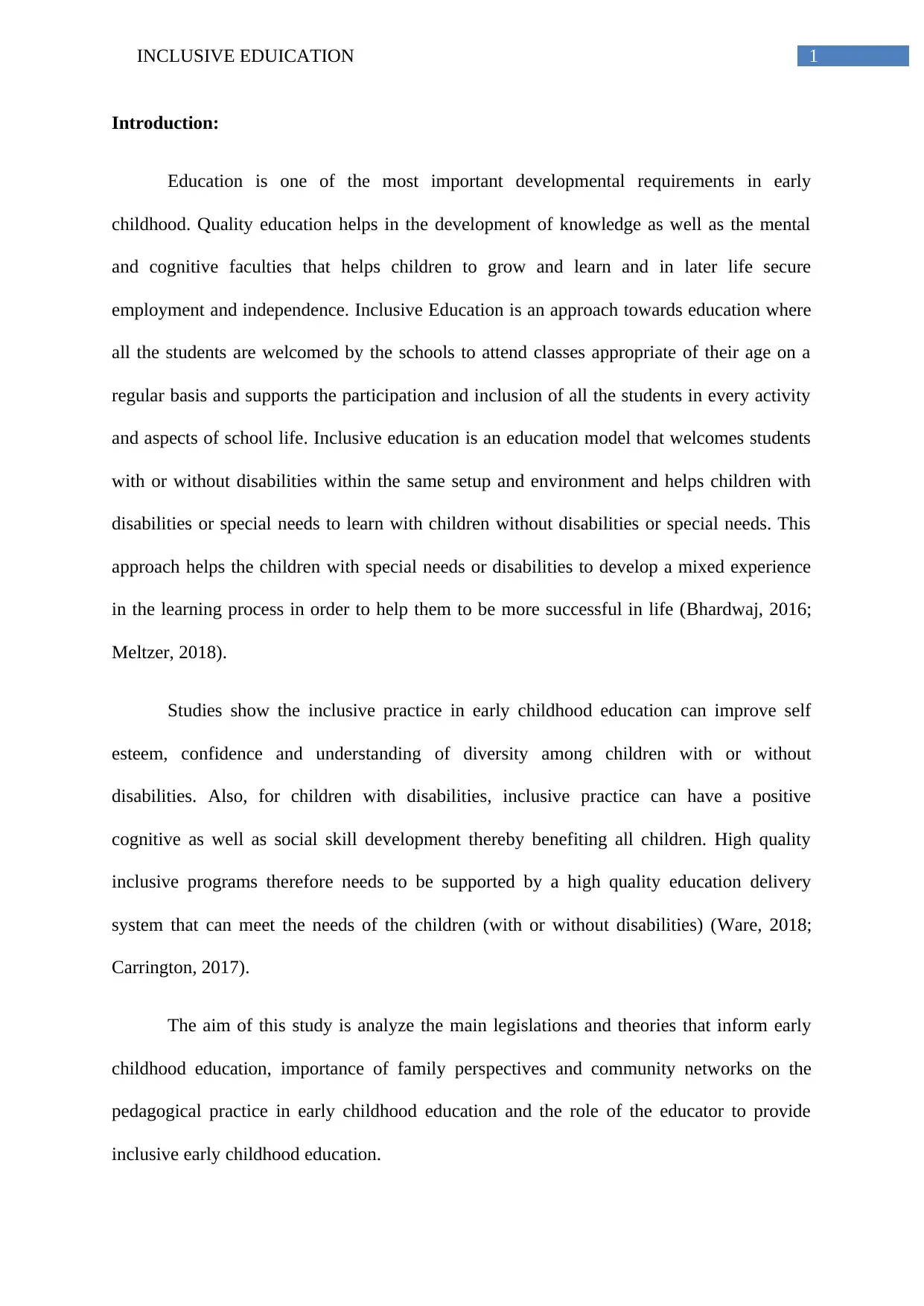
1INCLUSIVE EDUICATION
Introduction:
Education is one of the most important developmental requirements in early
childhood. Quality education helps in the development of knowledge as well as the mental
and cognitive faculties that helps children to grow and learn and in later life secure
employment and independence. Inclusive Education is an approach towards education where
all the students are welcomed by the schools to attend classes appropriate of their age on a
regular basis and supports the participation and inclusion of all the students in every activity
and aspects of school life. Inclusive education is an education model that welcomes students
with or without disabilities within the same setup and environment and helps children with
disabilities or special needs to learn with children without disabilities or special needs. This
approach helps the children with special needs or disabilities to develop a mixed experience
in the learning process in order to help them to be more successful in life (Bhardwaj, 2016;
Meltzer, 2018).
Studies show the inclusive practice in early childhood education can improve self
esteem, confidence and understanding of diversity among children with or without
disabilities. Also, for children with disabilities, inclusive practice can have a positive
cognitive as well as social skill development thereby benefiting all children. High quality
inclusive programs therefore needs to be supported by a high quality education delivery
system that can meet the needs of the children (with or without disabilities) (Ware, 2018;
Carrington, 2017).
The aim of this study is analyze the main legislations and theories that inform early
childhood education, importance of family perspectives and community networks on the
pedagogical practice in early childhood education and the role of the educator to provide
inclusive early childhood education.
Introduction:
Education is one of the most important developmental requirements in early
childhood. Quality education helps in the development of knowledge as well as the mental
and cognitive faculties that helps children to grow and learn and in later life secure
employment and independence. Inclusive Education is an approach towards education where
all the students are welcomed by the schools to attend classes appropriate of their age on a
regular basis and supports the participation and inclusion of all the students in every activity
and aspects of school life. Inclusive education is an education model that welcomes students
with or without disabilities within the same setup and environment and helps children with
disabilities or special needs to learn with children without disabilities or special needs. This
approach helps the children with special needs or disabilities to develop a mixed experience
in the learning process in order to help them to be more successful in life (Bhardwaj, 2016;
Meltzer, 2018).
Studies show the inclusive practice in early childhood education can improve self
esteem, confidence and understanding of diversity among children with or without
disabilities. Also, for children with disabilities, inclusive practice can have a positive
cognitive as well as social skill development thereby benefiting all children. High quality
inclusive programs therefore needs to be supported by a high quality education delivery
system that can meet the needs of the children (with or without disabilities) (Ware, 2018;
Carrington, 2017).
The aim of this study is analyze the main legislations and theories that inform early
childhood education, importance of family perspectives and community networks on the
pedagogical practice in early childhood education and the role of the educator to provide
inclusive early childhood education.
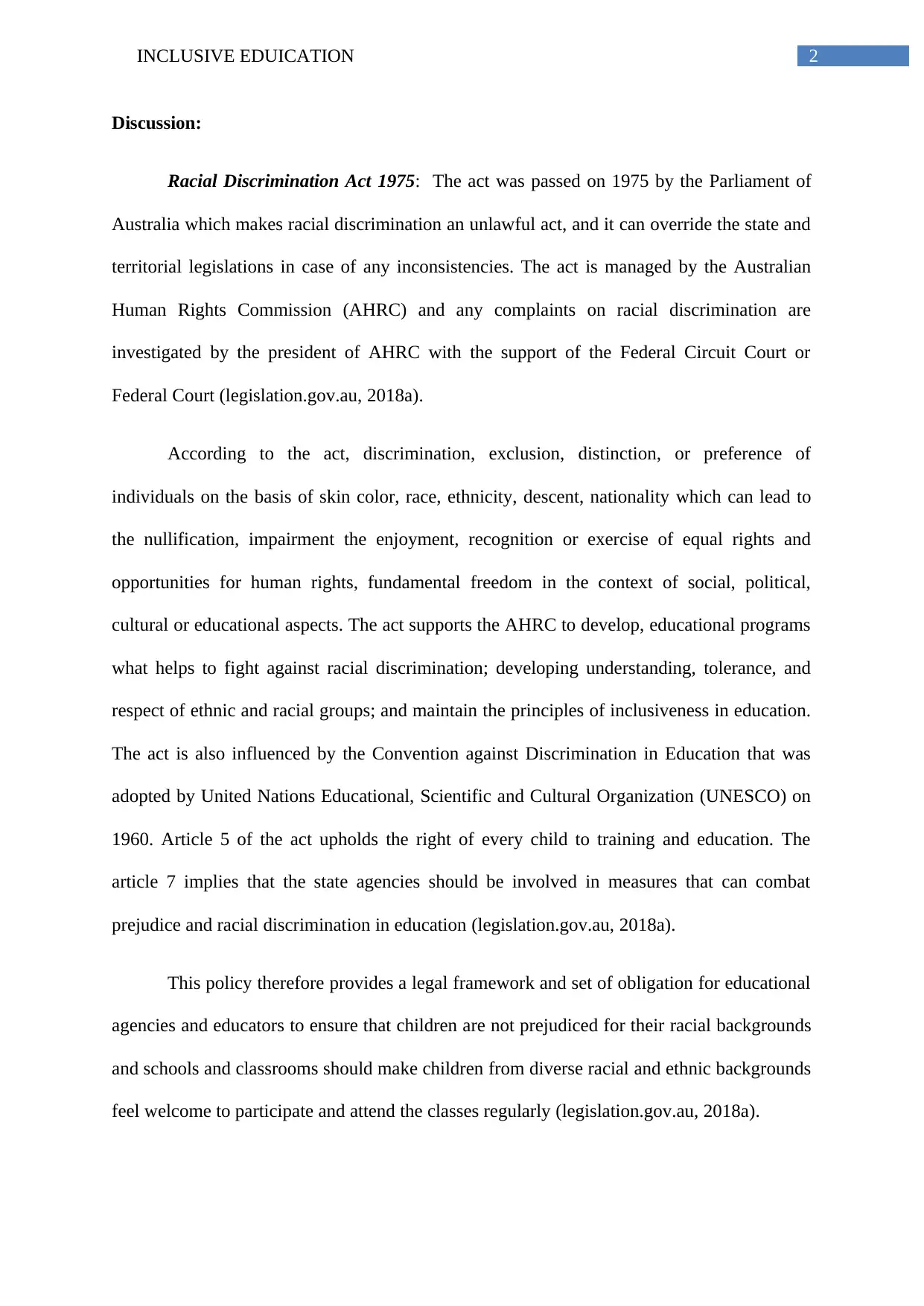
2INCLUSIVE EDUICATION
Discussion:
Racial Discrimination Act 1975: The act was passed on 1975 by the Parliament of
Australia which makes racial discrimination an unlawful act, and it can override the state and
territorial legislations in case of any inconsistencies. The act is managed by the Australian
Human Rights Commission (AHRC) and any complaints on racial discrimination are
investigated by the president of AHRC with the support of the Federal Circuit Court or
Federal Court (legislation.gov.au, 2018a).
According to the act, discrimination, exclusion, distinction, or preference of
individuals on the basis of skin color, race, ethnicity, descent, nationality which can lead to
the nullification, impairment the enjoyment, recognition or exercise of equal rights and
opportunities for human rights, fundamental freedom in the context of social, political,
cultural or educational aspects. The act supports the AHRC to develop, educational programs
what helps to fight against racial discrimination; developing understanding, tolerance, and
respect of ethnic and racial groups; and maintain the principles of inclusiveness in education.
The act is also influenced by the Convention against Discrimination in Education that was
adopted by United Nations Educational, Scientific and Cultural Organization (UNESCO) on
1960. Article 5 of the act upholds the right of every child to training and education. The
article 7 implies that the state agencies should be involved in measures that can combat
prejudice and racial discrimination in education (legislation.gov.au, 2018a).
This policy therefore provides a legal framework and set of obligation for educational
agencies and educators to ensure that children are not prejudiced for their racial backgrounds
and schools and classrooms should make children from diverse racial and ethnic backgrounds
feel welcome to participate and attend the classes regularly (legislation.gov.au, 2018a).
Discussion:
Racial Discrimination Act 1975: The act was passed on 1975 by the Parliament of
Australia which makes racial discrimination an unlawful act, and it can override the state and
territorial legislations in case of any inconsistencies. The act is managed by the Australian
Human Rights Commission (AHRC) and any complaints on racial discrimination are
investigated by the president of AHRC with the support of the Federal Circuit Court or
Federal Court (legislation.gov.au, 2018a).
According to the act, discrimination, exclusion, distinction, or preference of
individuals on the basis of skin color, race, ethnicity, descent, nationality which can lead to
the nullification, impairment the enjoyment, recognition or exercise of equal rights and
opportunities for human rights, fundamental freedom in the context of social, political,
cultural or educational aspects. The act supports the AHRC to develop, educational programs
what helps to fight against racial discrimination; developing understanding, tolerance, and
respect of ethnic and racial groups; and maintain the principles of inclusiveness in education.
The act is also influenced by the Convention against Discrimination in Education that was
adopted by United Nations Educational, Scientific and Cultural Organization (UNESCO) on
1960. Article 5 of the act upholds the right of every child to training and education. The
article 7 implies that the state agencies should be involved in measures that can combat
prejudice and racial discrimination in education (legislation.gov.au, 2018a).
This policy therefore provides a legal framework and set of obligation for educational
agencies and educators to ensure that children are not prejudiced for their racial backgrounds
and schools and classrooms should make children from diverse racial and ethnic backgrounds
feel welcome to participate and attend the classes regularly (legislation.gov.au, 2018a).
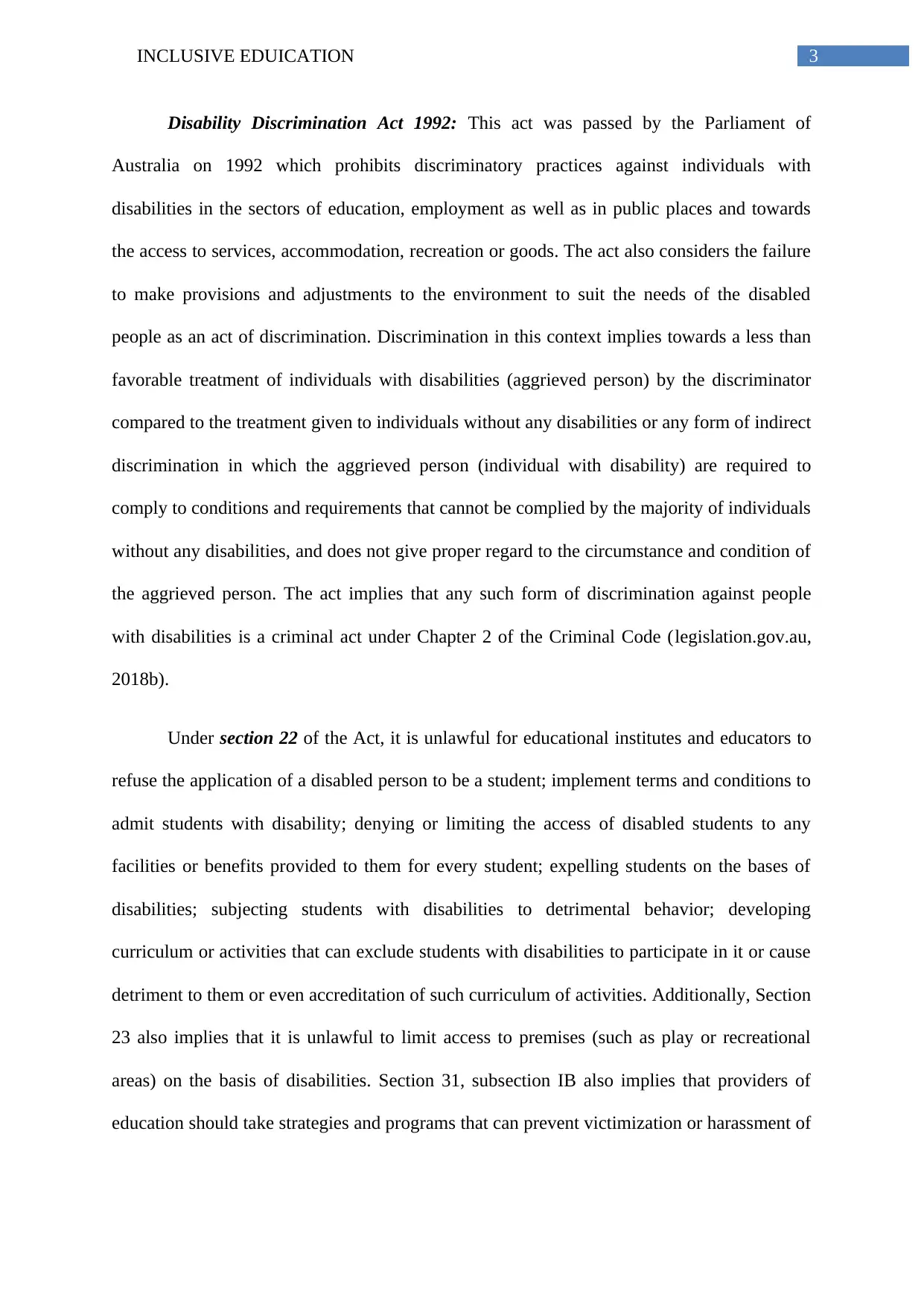
3INCLUSIVE EDUICATION
Disability Discrimination Act 1992: This act was passed by the Parliament of
Australia on 1992 which prohibits discriminatory practices against individuals with
disabilities in the sectors of education, employment as well as in public places and towards
the access to services, accommodation, recreation or goods. The act also considers the failure
to make provisions and adjustments to the environment to suit the needs of the disabled
people as an act of discrimination. Discrimination in this context implies towards a less than
favorable treatment of individuals with disabilities (aggrieved person) by the discriminator
compared to the treatment given to individuals without any disabilities or any form of indirect
discrimination in which the aggrieved person (individual with disability) are required to
comply to conditions and requirements that cannot be complied by the majority of individuals
without any disabilities, and does not give proper regard to the circumstance and condition of
the aggrieved person. The act implies that any such form of discrimination against people
with disabilities is a criminal act under Chapter 2 of the Criminal Code (legislation.gov.au,
2018b).
Under section 22 of the Act, it is unlawful for educational institutes and educators to
refuse the application of a disabled person to be a student; implement terms and conditions to
admit students with disability; denying or limiting the access of disabled students to any
facilities or benefits provided to them for every student; expelling students on the bases of
disabilities; subjecting students with disabilities to detrimental behavior; developing
curriculum or activities that can exclude students with disabilities to participate in it or cause
detriment to them or even accreditation of such curriculum of activities. Additionally, Section
23 also implies that it is unlawful to limit access to premises (such as play or recreational
areas) on the basis of disabilities. Section 31, subsection IB also implies that providers of
education should take strategies and programs that can prevent victimization or harassment of
Disability Discrimination Act 1992: This act was passed by the Parliament of
Australia on 1992 which prohibits discriminatory practices against individuals with
disabilities in the sectors of education, employment as well as in public places and towards
the access to services, accommodation, recreation or goods. The act also considers the failure
to make provisions and adjustments to the environment to suit the needs of the disabled
people as an act of discrimination. Discrimination in this context implies towards a less than
favorable treatment of individuals with disabilities (aggrieved person) by the discriminator
compared to the treatment given to individuals without any disabilities or any form of indirect
discrimination in which the aggrieved person (individual with disability) are required to
comply to conditions and requirements that cannot be complied by the majority of individuals
without any disabilities, and does not give proper regard to the circumstance and condition of
the aggrieved person. The act implies that any such form of discrimination against people
with disabilities is a criminal act under Chapter 2 of the Criminal Code (legislation.gov.au,
2018b).
Under section 22 of the Act, it is unlawful for educational institutes and educators to
refuse the application of a disabled person to be a student; implement terms and conditions to
admit students with disability; denying or limiting the access of disabled students to any
facilities or benefits provided to them for every student; expelling students on the bases of
disabilities; subjecting students with disabilities to detrimental behavior; developing
curriculum or activities that can exclude students with disabilities to participate in it or cause
detriment to them or even accreditation of such curriculum of activities. Additionally, Section
23 also implies that it is unlawful to limit access to premises (such as play or recreational
areas) on the basis of disabilities. Section 31, subsection IB also implies that providers of
education should take strategies and programs that can prevent victimization or harassment of
Secure Best Marks with AI Grader
Need help grading? Try our AI Grader for instant feedback on your assignments.
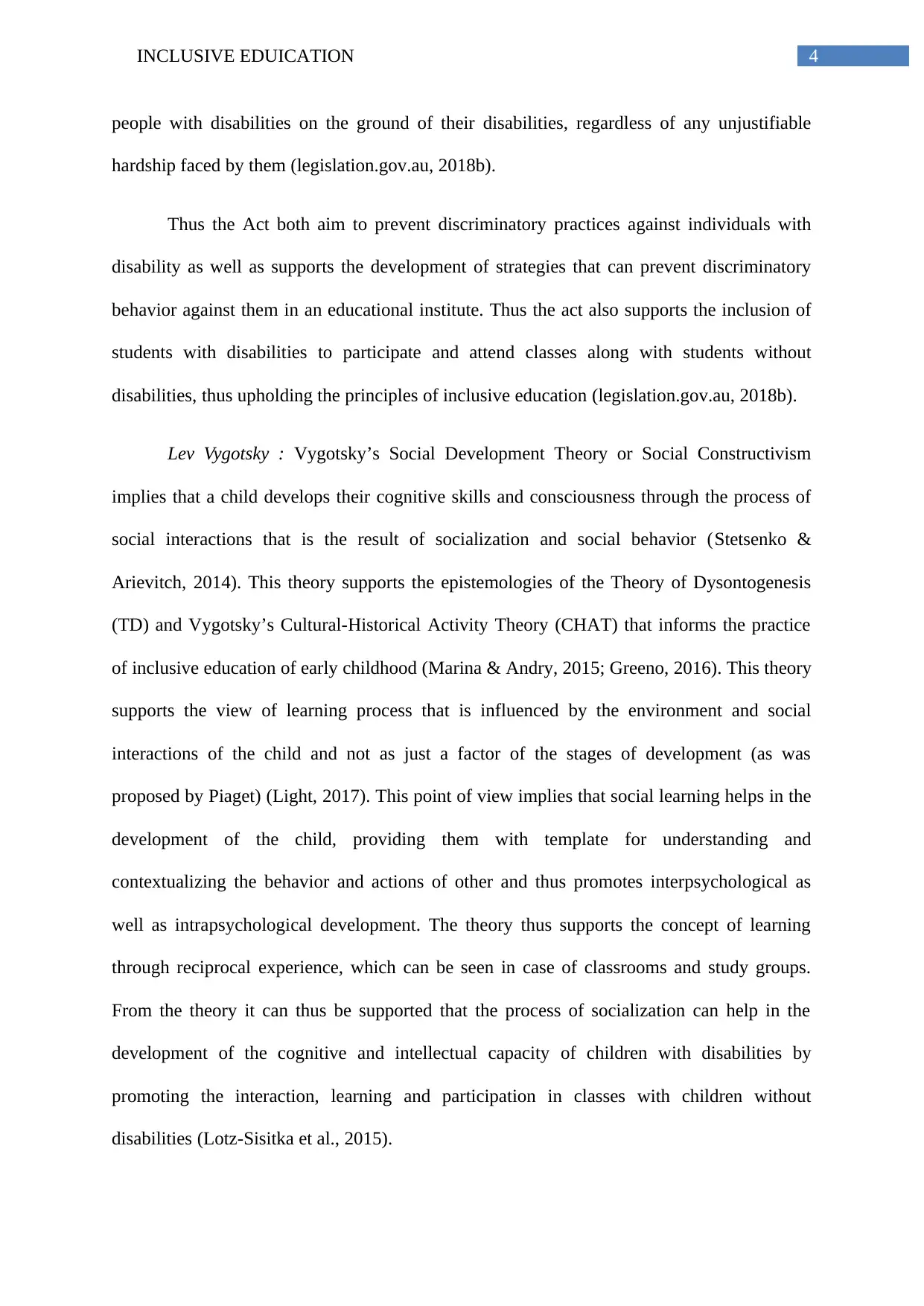
4INCLUSIVE EDUICATION
people with disabilities on the ground of their disabilities, regardless of any unjustifiable
hardship faced by them (legislation.gov.au, 2018b).
Thus the Act both aim to prevent discriminatory practices against individuals with
disability as well as supports the development of strategies that can prevent discriminatory
behavior against them in an educational institute. Thus the act also supports the inclusion of
students with disabilities to participate and attend classes along with students without
disabilities, thus upholding the principles of inclusive education (legislation.gov.au, 2018b).
Lev Vygotsky : Vygotsky’s Social Development Theory or Social Constructivism
implies that a child develops their cognitive skills and consciousness through the process of
social interactions that is the result of socialization and social behavior (Stetsenko &
Arievitch, 2014). This theory supports the epistemologies of the Theory of Dysontogenesis
(TD) and Vygotsky’s Cultural-Historical Activity Theory (CHAT) that informs the practice
of inclusive education of early childhood (Marina & Andry, 2015; Greeno, 2016). This theory
supports the view of learning process that is influenced by the environment and social
interactions of the child and not as just a factor of the stages of development (as was
proposed by Piaget) (Light, 2017). This point of view implies that social learning helps in the
development of the child, providing them with template for understanding and
contextualizing the behavior and actions of other and thus promotes interpsychological as
well as intrapsychological development. The theory thus supports the concept of learning
through reciprocal experience, which can be seen in case of classrooms and study groups.
From the theory it can thus be supported that the process of socialization can help in the
development of the cognitive and intellectual capacity of children with disabilities by
promoting the interaction, learning and participation in classes with children without
disabilities (Lotz-Sisitka et al., 2015).
people with disabilities on the ground of their disabilities, regardless of any unjustifiable
hardship faced by them (legislation.gov.au, 2018b).
Thus the Act both aim to prevent discriminatory practices against individuals with
disability as well as supports the development of strategies that can prevent discriminatory
behavior against them in an educational institute. Thus the act also supports the inclusion of
students with disabilities to participate and attend classes along with students without
disabilities, thus upholding the principles of inclusive education (legislation.gov.au, 2018b).
Lev Vygotsky : Vygotsky’s Social Development Theory or Social Constructivism
implies that a child develops their cognitive skills and consciousness through the process of
social interactions that is the result of socialization and social behavior (Stetsenko &
Arievitch, 2014). This theory supports the epistemologies of the Theory of Dysontogenesis
(TD) and Vygotsky’s Cultural-Historical Activity Theory (CHAT) that informs the practice
of inclusive education of early childhood (Marina & Andry, 2015; Greeno, 2016). This theory
supports the view of learning process that is influenced by the environment and social
interactions of the child and not as just a factor of the stages of development (as was
proposed by Piaget) (Light, 2017). This point of view implies that social learning helps in the
development of the child, providing them with template for understanding and
contextualizing the behavior and actions of other and thus promotes interpsychological as
well as intrapsychological development. The theory thus supports the concept of learning
through reciprocal experience, which can be seen in case of classrooms and study groups.
From the theory it can thus be supported that the process of socialization can help in the
development of the cognitive and intellectual capacity of children with disabilities by
promoting the interaction, learning and participation in classes with children without
disabilities (Lotz-Sisitka et al., 2015).
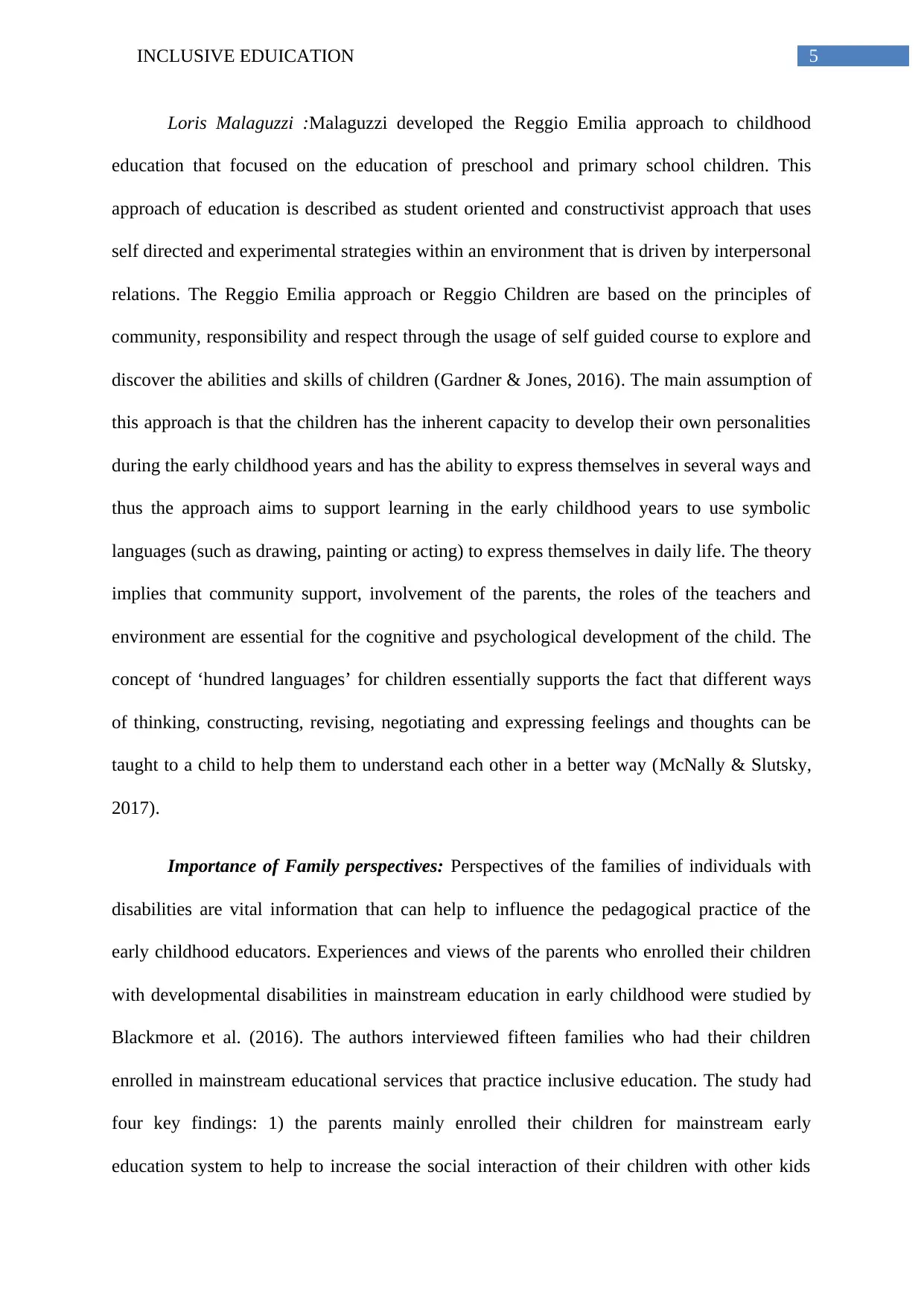
5INCLUSIVE EDUICATION
Loris Malaguzzi :Malaguzzi developed the Reggio Emilia approach to childhood
education that focused on the education of preschool and primary school children. This
approach of education is described as student oriented and constructivist approach that uses
self directed and experimental strategies within an environment that is driven by interpersonal
relations. The Reggio Emilia approach or Reggio Children are based on the principles of
community, responsibility and respect through the usage of self guided course to explore and
discover the abilities and skills of children (Gardner & Jones, 2016). The main assumption of
this approach is that the children has the inherent capacity to develop their own personalities
during the early childhood years and has the ability to express themselves in several ways and
thus the approach aims to support learning in the early childhood years to use symbolic
languages (such as drawing, painting or acting) to express themselves in daily life. The theory
implies that community support, involvement of the parents, the roles of the teachers and
environment are essential for the cognitive and psychological development of the child. The
concept of ‘hundred languages’ for children essentially supports the fact that different ways
of thinking, constructing, revising, negotiating and expressing feelings and thoughts can be
taught to a child to help them to understand each other in a better way (McNally & Slutsky,
2017).
Importance of Family perspectives: Perspectives of the families of individuals with
disabilities are vital information that can help to influence the pedagogical practice of the
early childhood educators. Experiences and views of the parents who enrolled their children
with developmental disabilities in mainstream education in early childhood were studied by
Blackmore et al. (2016). The authors interviewed fifteen families who had their children
enrolled in mainstream educational services that practice inclusive education. The study had
four key findings: 1) the parents mainly enrolled their children for mainstream early
education system to help to increase the social interaction of their children with other kids
Loris Malaguzzi :Malaguzzi developed the Reggio Emilia approach to childhood
education that focused on the education of preschool and primary school children. This
approach of education is described as student oriented and constructivist approach that uses
self directed and experimental strategies within an environment that is driven by interpersonal
relations. The Reggio Emilia approach or Reggio Children are based on the principles of
community, responsibility and respect through the usage of self guided course to explore and
discover the abilities and skills of children (Gardner & Jones, 2016). The main assumption of
this approach is that the children has the inherent capacity to develop their own personalities
during the early childhood years and has the ability to express themselves in several ways and
thus the approach aims to support learning in the early childhood years to use symbolic
languages (such as drawing, painting or acting) to express themselves in daily life. The theory
implies that community support, involvement of the parents, the roles of the teachers and
environment are essential for the cognitive and psychological development of the child. The
concept of ‘hundred languages’ for children essentially supports the fact that different ways
of thinking, constructing, revising, negotiating and expressing feelings and thoughts can be
taught to a child to help them to understand each other in a better way (McNally & Slutsky,
2017).
Importance of Family perspectives: Perspectives of the families of individuals with
disabilities are vital information that can help to influence the pedagogical practice of the
early childhood educators. Experiences and views of the parents who enrolled their children
with developmental disabilities in mainstream education in early childhood were studied by
Blackmore et al. (2016). The authors interviewed fifteen families who had their children
enrolled in mainstream educational services that practice inclusive education. The study had
four key findings: 1) the parents mainly enrolled their children for mainstream early
education system to help to increase the social interaction of their children with other kids
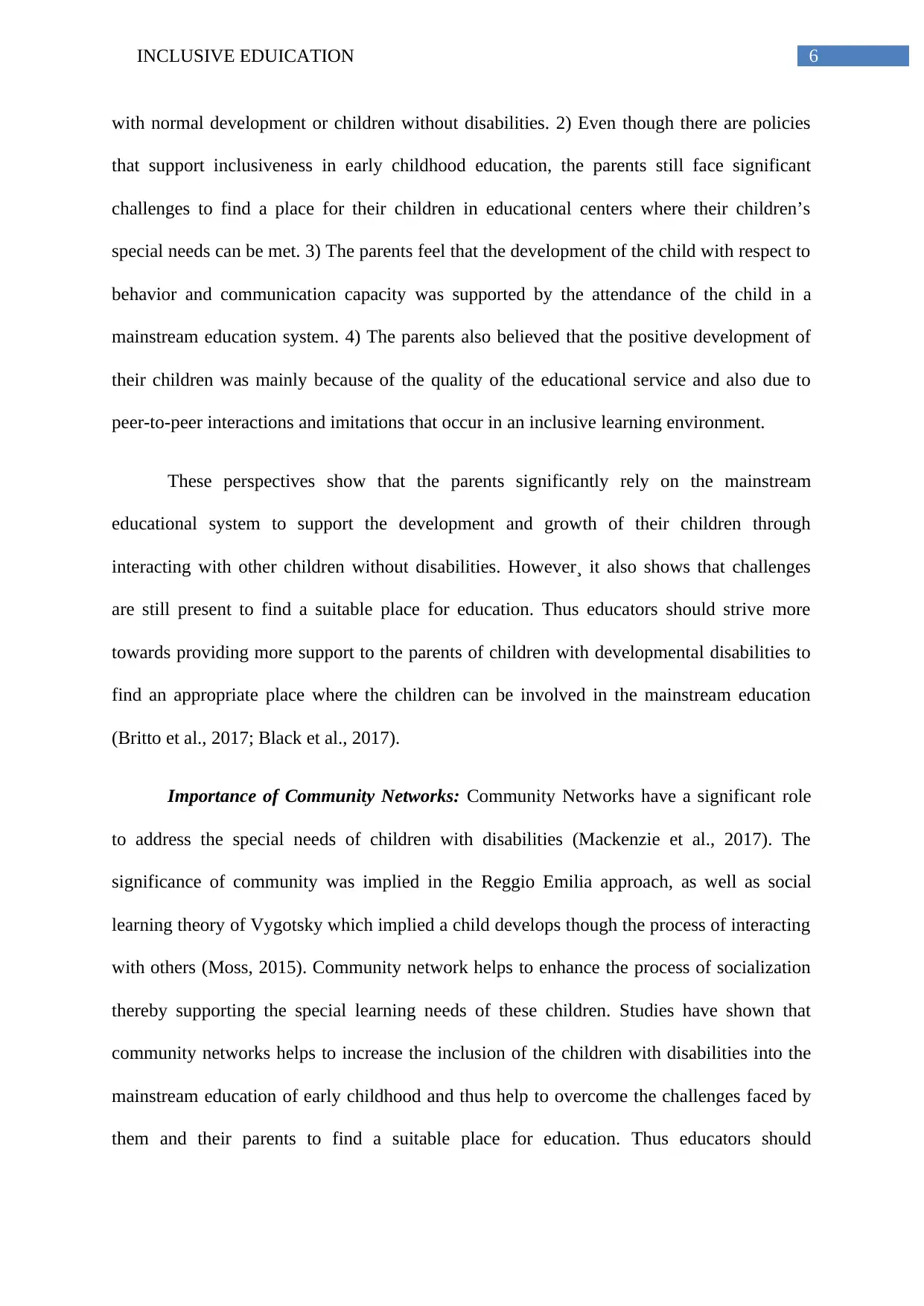
6INCLUSIVE EDUICATION
with normal development or children without disabilities. 2) Even though there are policies
that support inclusiveness in early childhood education, the parents still face significant
challenges to find a place for their children in educational centers where their children’s
special needs can be met. 3) The parents feel that the development of the child with respect to
behavior and communication capacity was supported by the attendance of the child in a
mainstream education system. 4) The parents also believed that the positive development of
their children was mainly because of the quality of the educational service and also due to
peer-to-peer interactions and imitations that occur in an inclusive learning environment.
These perspectives show that the parents significantly rely on the mainstream
educational system to support the development and growth of their children through
interacting with other children without disabilities. However¸ it also shows that challenges
are still present to find a suitable place for education. Thus educators should strive more
towards providing more support to the parents of children with developmental disabilities to
find an appropriate place where the children can be involved in the mainstream education
(Britto et al., 2017; Black et al., 2017).
Importance of Community Networks: Community Networks have a significant role
to address the special needs of children with disabilities (Mackenzie et al., 2017). The
significance of community was implied in the Reggio Emilia approach, as well as social
learning theory of Vygotsky which implied a child develops though the process of interacting
with others (Moss, 2015). Community network helps to enhance the process of socialization
thereby supporting the special learning needs of these children. Studies have shown that
community networks helps to increase the inclusion of the children with disabilities into the
mainstream education of early childhood and thus help to overcome the challenges faced by
them and their parents to find a suitable place for education. Thus educators should
with normal development or children without disabilities. 2) Even though there are policies
that support inclusiveness in early childhood education, the parents still face significant
challenges to find a place for their children in educational centers where their children’s
special needs can be met. 3) The parents feel that the development of the child with respect to
behavior and communication capacity was supported by the attendance of the child in a
mainstream education system. 4) The parents also believed that the positive development of
their children was mainly because of the quality of the educational service and also due to
peer-to-peer interactions and imitations that occur in an inclusive learning environment.
These perspectives show that the parents significantly rely on the mainstream
educational system to support the development and growth of their children through
interacting with other children without disabilities. However¸ it also shows that challenges
are still present to find a suitable place for education. Thus educators should strive more
towards providing more support to the parents of children with developmental disabilities to
find an appropriate place where the children can be involved in the mainstream education
(Britto et al., 2017; Black et al., 2017).
Importance of Community Networks: Community Networks have a significant role
to address the special needs of children with disabilities (Mackenzie et al., 2017). The
significance of community was implied in the Reggio Emilia approach, as well as social
learning theory of Vygotsky which implied a child develops though the process of interacting
with others (Moss, 2015). Community network helps to enhance the process of socialization
thereby supporting the special learning needs of these children. Studies have shown that
community networks helps to increase the inclusion of the children with disabilities into the
mainstream education of early childhood and thus help to overcome the challenges faced by
them and their parents to find a suitable place for education. Thus educators should
Paraphrase This Document
Need a fresh take? Get an instant paraphrase of this document with our AI Paraphraser
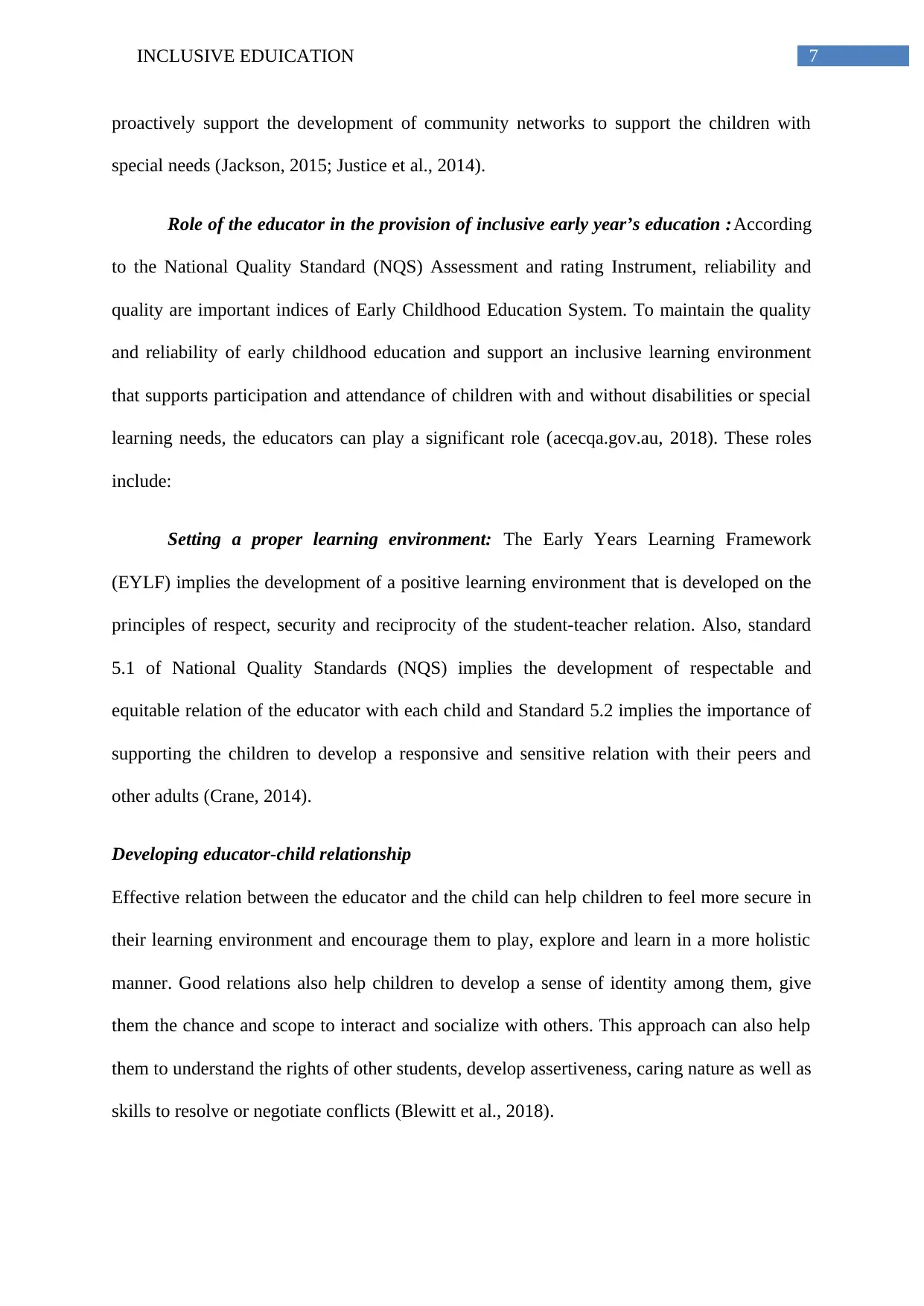
7INCLUSIVE EDUICATION
proactively support the development of community networks to support the children with
special needs (Jackson, 2015; Justice et al., 2014).
Role of the educator in the provision of inclusive early year’s education :According
to the National Quality Standard (NQS) Assessment and rating Instrument, reliability and
quality are important indices of Early Childhood Education System. To maintain the quality
and reliability of early childhood education and support an inclusive learning environment
that supports participation and attendance of children with and without disabilities or special
learning needs, the educators can play a significant role (acecqa.gov.au, 2018). These roles
include:
Setting a proper learning environment: The Early Years Learning Framework
(EYLF) implies the development of a positive learning environment that is developed on the
principles of respect, security and reciprocity of the student-teacher relation. Also, standard
5.1 of National Quality Standards (NQS) implies the development of respectable and
equitable relation of the educator with each child and Standard 5.2 implies the importance of
supporting the children to develop a responsive and sensitive relation with their peers and
other adults (Crane, 2014).
Developing educator-child relationship
Effective relation between the educator and the child can help children to feel more secure in
their learning environment and encourage them to play, explore and learn in a more holistic
manner. Good relations also help children to develop a sense of identity among them, give
them the chance and scope to interact and socialize with others. This approach can also help
them to understand the rights of other students, develop assertiveness, caring nature as well as
skills to resolve or negotiate conflicts (Blewitt et al., 2018).
proactively support the development of community networks to support the children with
special needs (Jackson, 2015; Justice et al., 2014).
Role of the educator in the provision of inclusive early year’s education :According
to the National Quality Standard (NQS) Assessment and rating Instrument, reliability and
quality are important indices of Early Childhood Education System. To maintain the quality
and reliability of early childhood education and support an inclusive learning environment
that supports participation and attendance of children with and without disabilities or special
learning needs, the educators can play a significant role (acecqa.gov.au, 2018). These roles
include:
Setting a proper learning environment: The Early Years Learning Framework
(EYLF) implies the development of a positive learning environment that is developed on the
principles of respect, security and reciprocity of the student-teacher relation. Also, standard
5.1 of National Quality Standards (NQS) implies the development of respectable and
equitable relation of the educator with each child and Standard 5.2 implies the importance of
supporting the children to develop a responsive and sensitive relation with their peers and
other adults (Crane, 2014).
Developing educator-child relationship
Effective relation between the educator and the child can help children to feel more secure in
their learning environment and encourage them to play, explore and learn in a more holistic
manner. Good relations also help children to develop a sense of identity among them, give
them the chance and scope to interact and socialize with others. This approach can also help
them to understand the rights of other students, develop assertiveness, caring nature as well as
skills to resolve or negotiate conflicts (Blewitt et al., 2018).
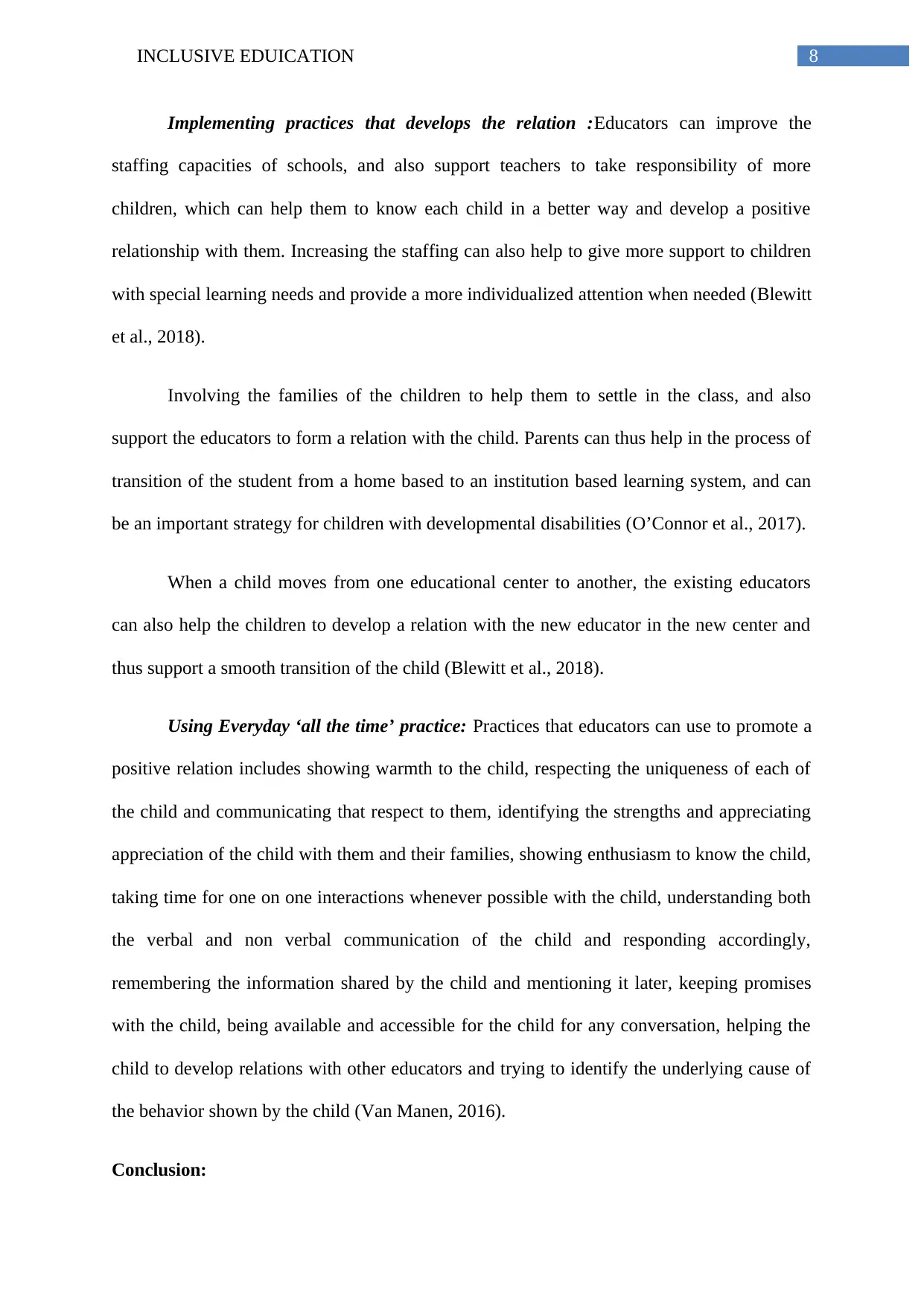
8INCLUSIVE EDUICATION
Implementing practices that develops the relation :Educators can improve the
staffing capacities of schools, and also support teachers to take responsibility of more
children, which can help them to know each child in a better way and develop a positive
relationship with them. Increasing the staffing can also help to give more support to children
with special learning needs and provide a more individualized attention when needed (Blewitt
et al., 2018).
Involving the families of the children to help them to settle in the class, and also
support the educators to form a relation with the child. Parents can thus help in the process of
transition of the student from a home based to an institution based learning system, and can
be an important strategy for children with developmental disabilities (O’Connor et al., 2017).
When a child moves from one educational center to another, the existing educators
can also help the children to develop a relation with the new educator in the new center and
thus support a smooth transition of the child (Blewitt et al., 2018).
Using Everyday ‘all the time’ practice: Practices that educators can use to promote a
positive relation includes showing warmth to the child, respecting the uniqueness of each of
the child and communicating that respect to them, identifying the strengths and appreciating
appreciation of the child with them and their families, showing enthusiasm to know the child,
taking time for one on one interactions whenever possible with the child, understanding both
the verbal and non verbal communication of the child and responding accordingly,
remembering the information shared by the child and mentioning it later, keeping promises
with the child, being available and accessible for the child for any conversation, helping the
child to develop relations with other educators and trying to identify the underlying cause of
the behavior shown by the child (Van Manen, 2016).
Conclusion:
Implementing practices that develops the relation :Educators can improve the
staffing capacities of schools, and also support teachers to take responsibility of more
children, which can help them to know each child in a better way and develop a positive
relationship with them. Increasing the staffing can also help to give more support to children
with special learning needs and provide a more individualized attention when needed (Blewitt
et al., 2018).
Involving the families of the children to help them to settle in the class, and also
support the educators to form a relation with the child. Parents can thus help in the process of
transition of the student from a home based to an institution based learning system, and can
be an important strategy for children with developmental disabilities (O’Connor et al., 2017).
When a child moves from one educational center to another, the existing educators
can also help the children to develop a relation with the new educator in the new center and
thus support a smooth transition of the child (Blewitt et al., 2018).
Using Everyday ‘all the time’ practice: Practices that educators can use to promote a
positive relation includes showing warmth to the child, respecting the uniqueness of each of
the child and communicating that respect to them, identifying the strengths and appreciating
appreciation of the child with them and their families, showing enthusiasm to know the child,
taking time for one on one interactions whenever possible with the child, understanding both
the verbal and non verbal communication of the child and responding accordingly,
remembering the information shared by the child and mentioning it later, keeping promises
with the child, being available and accessible for the child for any conversation, helping the
child to develop relations with other educators and trying to identify the underlying cause of
the behavior shown by the child (Van Manen, 2016).
Conclusion:
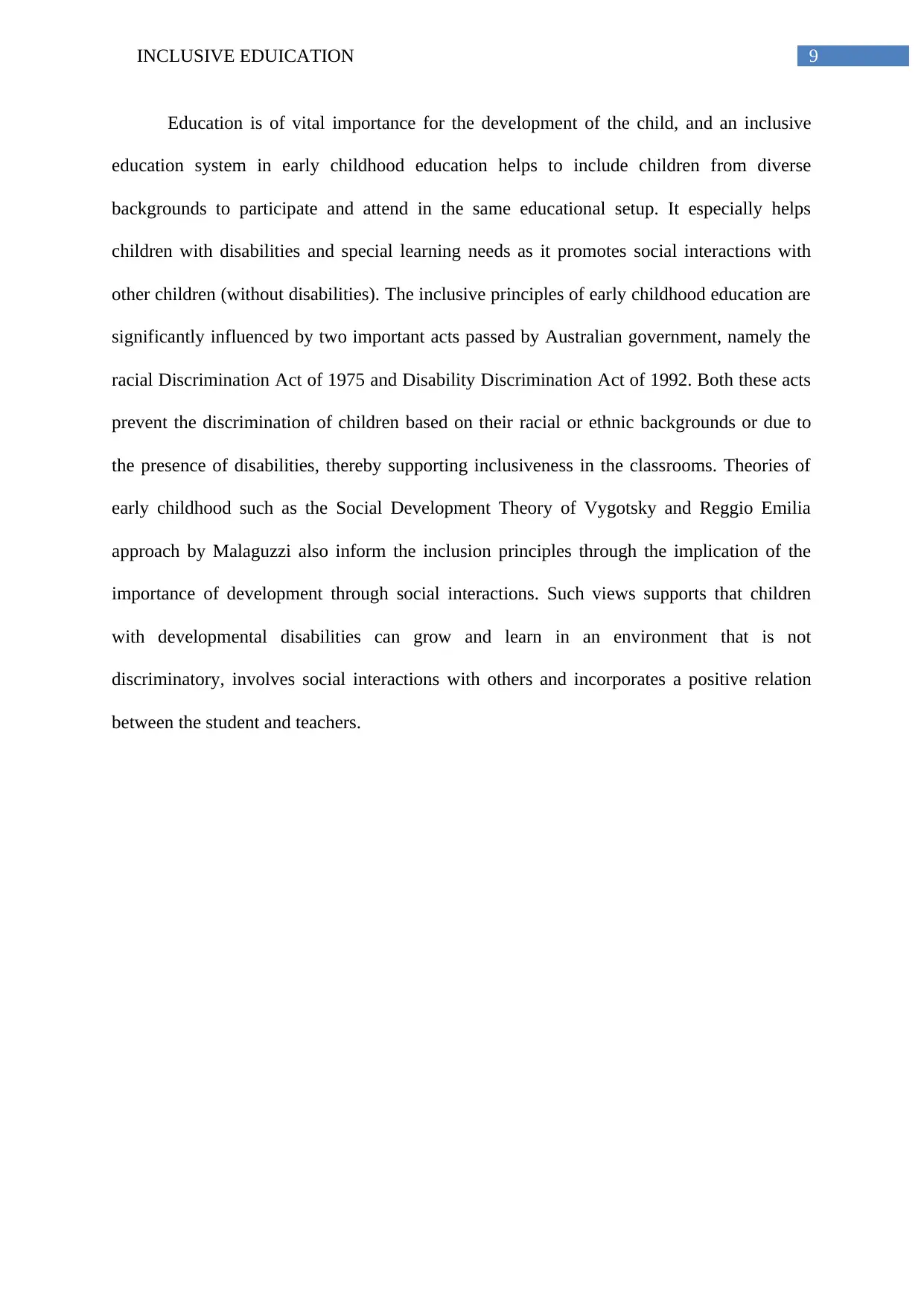
9INCLUSIVE EDUICATION
Education is of vital importance for the development of the child, and an inclusive
education system in early childhood education helps to include children from diverse
backgrounds to participate and attend in the same educational setup. It especially helps
children with disabilities and special learning needs as it promotes social interactions with
other children (without disabilities). The inclusive principles of early childhood education are
significantly influenced by two important acts passed by Australian government, namely the
racial Discrimination Act of 1975 and Disability Discrimination Act of 1992. Both these acts
prevent the discrimination of children based on their racial or ethnic backgrounds or due to
the presence of disabilities, thereby supporting inclusiveness in the classrooms. Theories of
early childhood such as the Social Development Theory of Vygotsky and Reggio Emilia
approach by Malaguzzi also inform the inclusion principles through the implication of the
importance of development through social interactions. Such views supports that children
with developmental disabilities can grow and learn in an environment that is not
discriminatory, involves social interactions with others and incorporates a positive relation
between the student and teachers.
Education is of vital importance for the development of the child, and an inclusive
education system in early childhood education helps to include children from diverse
backgrounds to participate and attend in the same educational setup. It especially helps
children with disabilities and special learning needs as it promotes social interactions with
other children (without disabilities). The inclusive principles of early childhood education are
significantly influenced by two important acts passed by Australian government, namely the
racial Discrimination Act of 1975 and Disability Discrimination Act of 1992. Both these acts
prevent the discrimination of children based on their racial or ethnic backgrounds or due to
the presence of disabilities, thereby supporting inclusiveness in the classrooms. Theories of
early childhood such as the Social Development Theory of Vygotsky and Reggio Emilia
approach by Malaguzzi also inform the inclusion principles through the implication of the
importance of development through social interactions. Such views supports that children
with developmental disabilities can grow and learn in an environment that is not
discriminatory, involves social interactions with others and incorporates a positive relation
between the student and teachers.
Secure Best Marks with AI Grader
Need help grading? Try our AI Grader for instant feedback on your assignments.
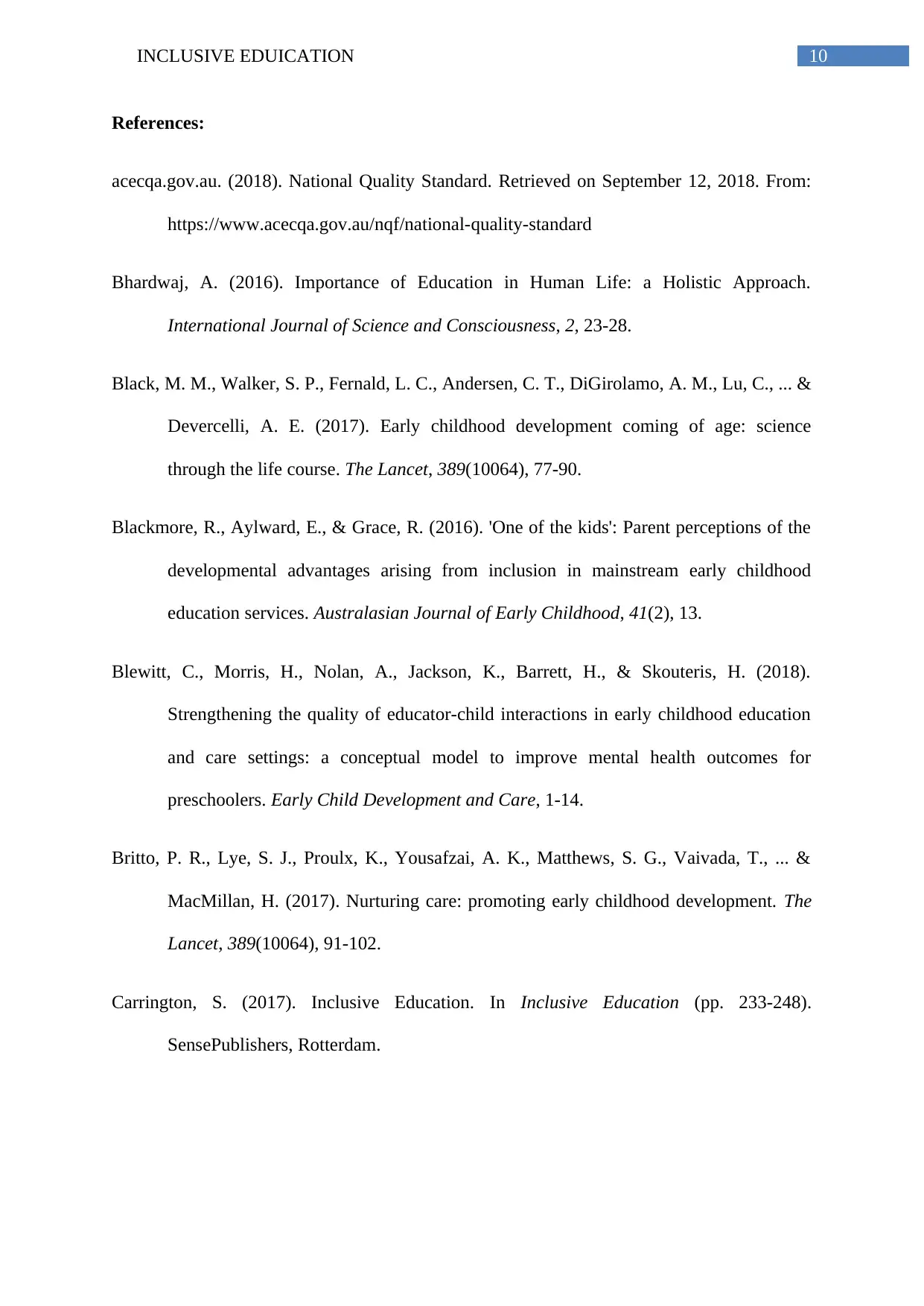
10INCLUSIVE EDUICATION
References:
acecqa.gov.au. (2018). National Quality Standard. Retrieved on September 12, 2018. From:
https://www.acecqa.gov.au/nqf/national-quality-standard
Bhardwaj, A. (2016). Importance of Education in Human Life: a Holistic Approach.
International Journal of Science and Consciousness, 2, 23-28.
Black, M. M., Walker, S. P., Fernald, L. C., Andersen, C. T., DiGirolamo, A. M., Lu, C., ... &
Devercelli, A. E. (2017). Early childhood development coming of age: science
through the life course. The Lancet, 389(10064), 77-90.
Blackmore, R., Aylward, E., & Grace, R. (2016). 'One of the kids': Parent perceptions of the
developmental advantages arising from inclusion in mainstream early childhood
education services. Australasian Journal of Early Childhood, 41(2), 13.
Blewitt, C., Morris, H., Nolan, A., Jackson, K., Barrett, H., & Skouteris, H. (2018).
Strengthening the quality of educator-child interactions in early childhood education
and care settings: a conceptual model to improve mental health outcomes for
preschoolers. Early Child Development and Care, 1-14.
Britto, P. R., Lye, S. J., Proulx, K., Yousafzai, A. K., Matthews, S. G., Vaivada, T., ... &
MacMillan, H. (2017). Nurturing care: promoting early childhood development. The
Lancet, 389(10064), 91-102.
Carrington, S. (2017). Inclusive Education. In Inclusive Education (pp. 233-248).
SensePublishers, Rotterdam.
References:
acecqa.gov.au. (2018). National Quality Standard. Retrieved on September 12, 2018. From:
https://www.acecqa.gov.au/nqf/national-quality-standard
Bhardwaj, A. (2016). Importance of Education in Human Life: a Holistic Approach.
International Journal of Science and Consciousness, 2, 23-28.
Black, M. M., Walker, S. P., Fernald, L. C., Andersen, C. T., DiGirolamo, A. M., Lu, C., ... &
Devercelli, A. E. (2017). Early childhood development coming of age: science
through the life course. The Lancet, 389(10064), 77-90.
Blackmore, R., Aylward, E., & Grace, R. (2016). 'One of the kids': Parent perceptions of the
developmental advantages arising from inclusion in mainstream early childhood
education services. Australasian Journal of Early Childhood, 41(2), 13.
Blewitt, C., Morris, H., Nolan, A., Jackson, K., Barrett, H., & Skouteris, H. (2018).
Strengthening the quality of educator-child interactions in early childhood education
and care settings: a conceptual model to improve mental health outcomes for
preschoolers. Early Child Development and Care, 1-14.
Britto, P. R., Lye, S. J., Proulx, K., Yousafzai, A. K., Matthews, S. G., Vaivada, T., ... &
MacMillan, H. (2017). Nurturing care: promoting early childhood development. The
Lancet, 389(10064), 91-102.
Carrington, S. (2017). Inclusive Education. In Inclusive Education (pp. 233-248).
SensePublishers, Rotterdam.
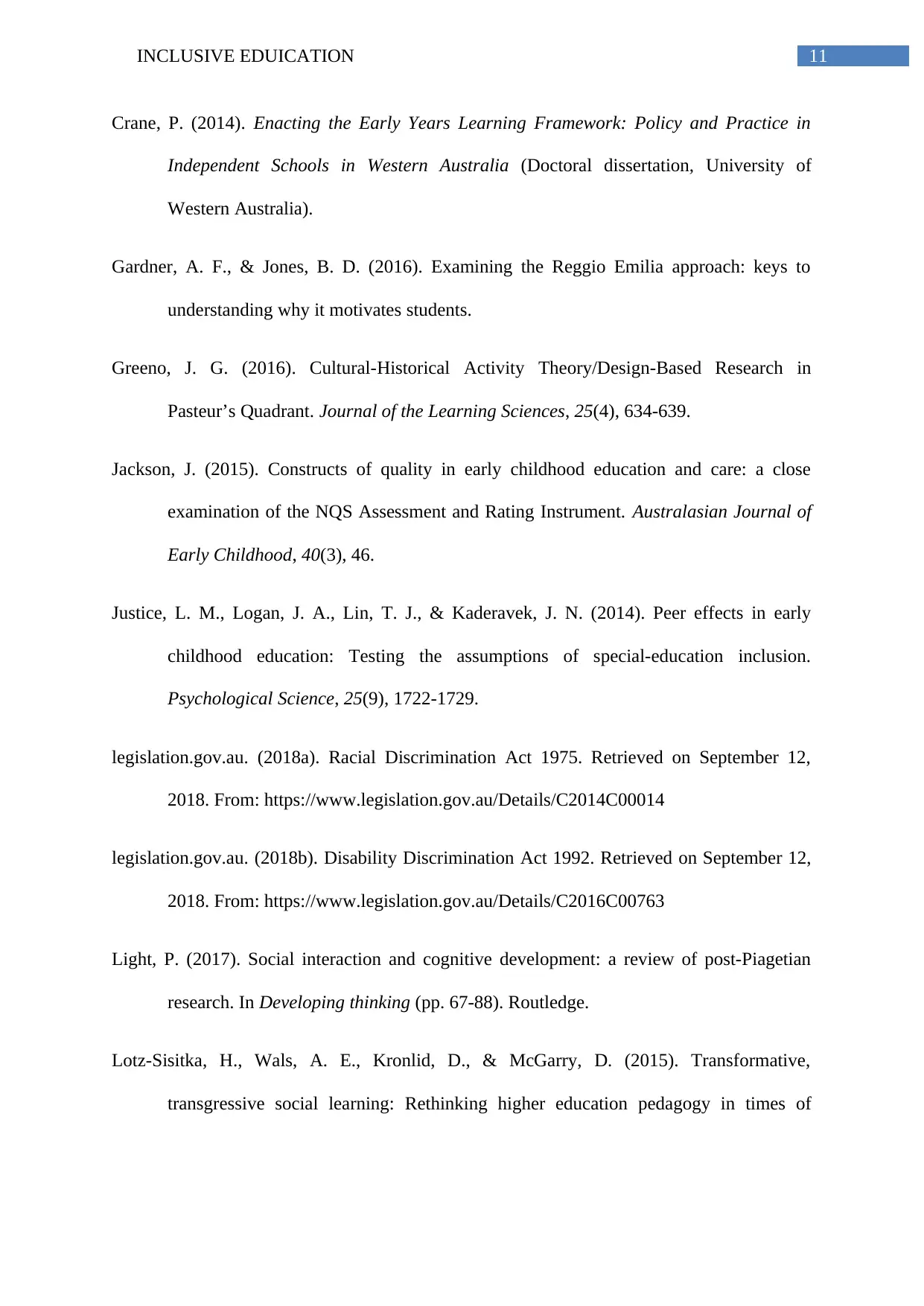
11INCLUSIVE EDUICATION
Crane, P. (2014). Enacting the Early Years Learning Framework: Policy and Practice in
Independent Schools in Western Australia (Doctoral dissertation, University of
Western Australia).
Gardner, A. F., & Jones, B. D. (2016). Examining the Reggio Emilia approach: keys to
understanding why it motivates students.
Greeno, J. G. (2016). Cultural-Historical Activity Theory/Design-Based Research in
Pasteur’s Quadrant. Journal of the Learning Sciences, 25(4), 634-639.
Jackson, J. (2015). Constructs of quality in early childhood education and care: a close
examination of the NQS Assessment and Rating Instrument. Australasian Journal of
Early Childhood, 40(3), 46.
Justice, L. M., Logan, J. A., Lin, T. J., & Kaderavek, J. N. (2014). Peer effects in early
childhood education: Testing the assumptions of special-education inclusion.
Psychological Science, 25(9), 1722-1729.
legislation.gov.au. (2018a). Racial Discrimination Act 1975. Retrieved on September 12,
2018. From: https://www.legislation.gov.au/Details/C2014C00014
legislation.gov.au. (2018b). Disability Discrimination Act 1992. Retrieved on September 12,
2018. From: https://www.legislation.gov.au/Details/C2016C00763
Light, P. (2017). Social interaction and cognitive development: a review of post-Piagetian
research. In Developing thinking (pp. 67-88). Routledge.
Lotz-Sisitka, H., Wals, A. E., Kronlid, D., & McGarry, D. (2015). Transformative,
transgressive social learning: Rethinking higher education pedagogy in times of
Crane, P. (2014). Enacting the Early Years Learning Framework: Policy and Practice in
Independent Schools in Western Australia (Doctoral dissertation, University of
Western Australia).
Gardner, A. F., & Jones, B. D. (2016). Examining the Reggio Emilia approach: keys to
understanding why it motivates students.
Greeno, J. G. (2016). Cultural-Historical Activity Theory/Design-Based Research in
Pasteur’s Quadrant. Journal of the Learning Sciences, 25(4), 634-639.
Jackson, J. (2015). Constructs of quality in early childhood education and care: a close
examination of the NQS Assessment and Rating Instrument. Australasian Journal of
Early Childhood, 40(3), 46.
Justice, L. M., Logan, J. A., Lin, T. J., & Kaderavek, J. N. (2014). Peer effects in early
childhood education: Testing the assumptions of special-education inclusion.
Psychological Science, 25(9), 1722-1729.
legislation.gov.au. (2018a). Racial Discrimination Act 1975. Retrieved on September 12,
2018. From: https://www.legislation.gov.au/Details/C2014C00014
legislation.gov.au. (2018b). Disability Discrimination Act 1992. Retrieved on September 12,
2018. From: https://www.legislation.gov.au/Details/C2016C00763
Light, P. (2017). Social interaction and cognitive development: a review of post-Piagetian
research. In Developing thinking (pp. 67-88). Routledge.
Lotz-Sisitka, H., Wals, A. E., Kronlid, D., & McGarry, D. (2015). Transformative,
transgressive social learning: Rethinking higher education pedagogy in times of
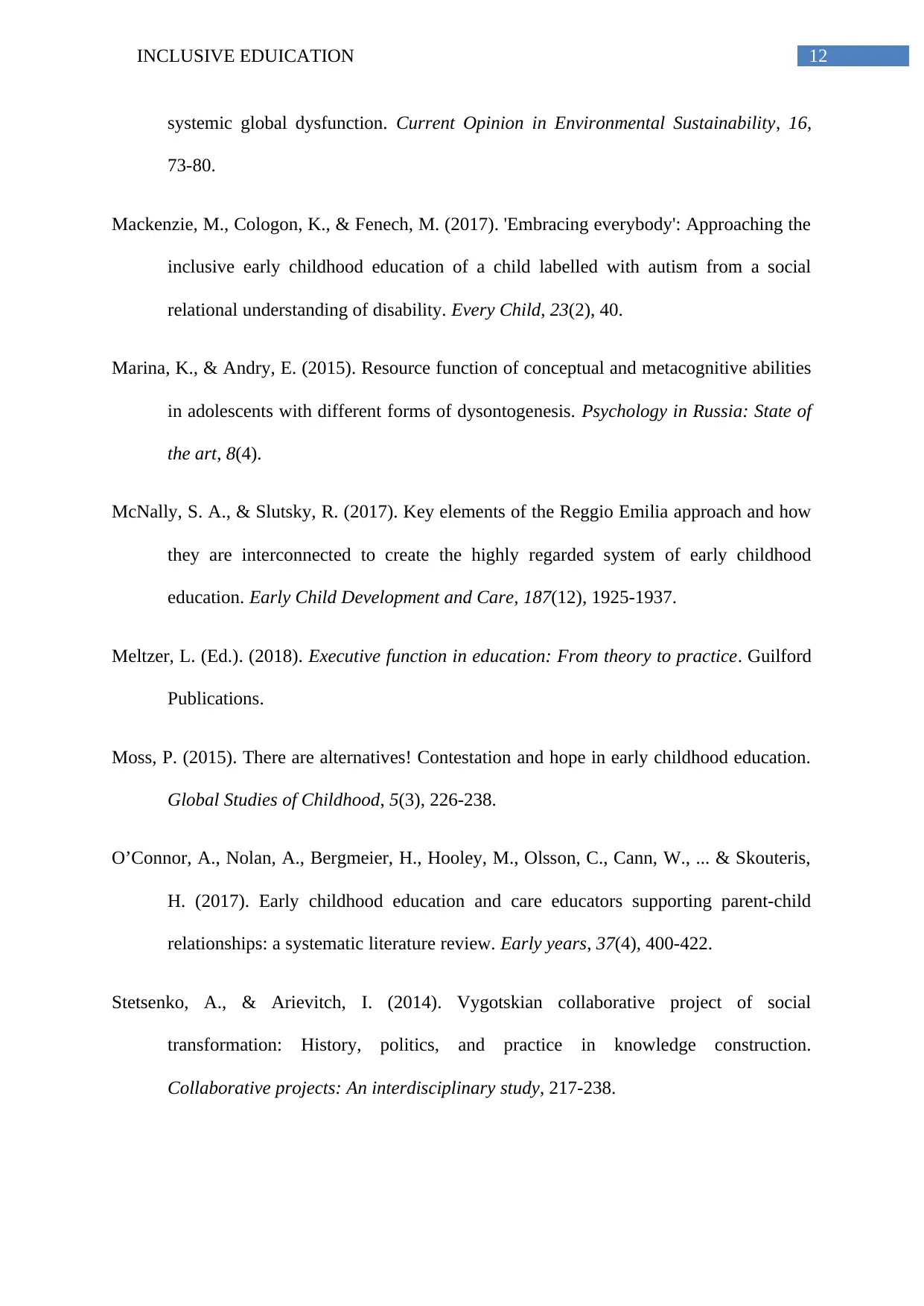
12INCLUSIVE EDUICATION
systemic global dysfunction. Current Opinion in Environmental Sustainability, 16,
73-80.
Mackenzie, M., Cologon, K., & Fenech, M. (2017). 'Embracing everybody': Approaching the
inclusive early childhood education of a child labelled with autism from a social
relational understanding of disability. Every Child, 23(2), 40.
Marina, K., & Andry, E. (2015). Resource function of conceptual and metacognitive abilities
in adolescents with different forms of dysontogenesis. Psychology in Russia: State of
the art, 8(4).
McNally, S. A., & Slutsky, R. (2017). Key elements of the Reggio Emilia approach and how
they are interconnected to create the highly regarded system of early childhood
education. Early Child Development and Care, 187(12), 1925-1937.
Meltzer, L. (Ed.). (2018). Executive function in education: From theory to practice. Guilford
Publications.
Moss, P. (2015). There are alternatives! Contestation and hope in early childhood education.
Global Studies of Childhood, 5(3), 226-238.
O’Connor, A., Nolan, A., Bergmeier, H., Hooley, M., Olsson, C., Cann, W., ... & Skouteris,
H. (2017). Early childhood education and care educators supporting parent-child
relationships: a systematic literature review. Early years, 37(4), 400-422.
Stetsenko, A., & Arievitch, I. (2014). Vygotskian collaborative project of social
transformation: History, politics, and practice in knowledge construction.
Collaborative projects: An interdisciplinary study, 217-238.
systemic global dysfunction. Current Opinion in Environmental Sustainability, 16,
73-80.
Mackenzie, M., Cologon, K., & Fenech, M. (2017). 'Embracing everybody': Approaching the
inclusive early childhood education of a child labelled with autism from a social
relational understanding of disability. Every Child, 23(2), 40.
Marina, K., & Andry, E. (2015). Resource function of conceptual and metacognitive abilities
in adolescents with different forms of dysontogenesis. Psychology in Russia: State of
the art, 8(4).
McNally, S. A., & Slutsky, R. (2017). Key elements of the Reggio Emilia approach and how
they are interconnected to create the highly regarded system of early childhood
education. Early Child Development and Care, 187(12), 1925-1937.
Meltzer, L. (Ed.). (2018). Executive function in education: From theory to practice. Guilford
Publications.
Moss, P. (2015). There are alternatives! Contestation and hope in early childhood education.
Global Studies of Childhood, 5(3), 226-238.
O’Connor, A., Nolan, A., Bergmeier, H., Hooley, M., Olsson, C., Cann, W., ... & Skouteris,
H. (2017). Early childhood education and care educators supporting parent-child
relationships: a systematic literature review. Early years, 37(4), 400-422.
Stetsenko, A., & Arievitch, I. (2014). Vygotskian collaborative project of social
transformation: History, politics, and practice in knowledge construction.
Collaborative projects: An interdisciplinary study, 217-238.
Paraphrase This Document
Need a fresh take? Get an instant paraphrase of this document with our AI Paraphraser
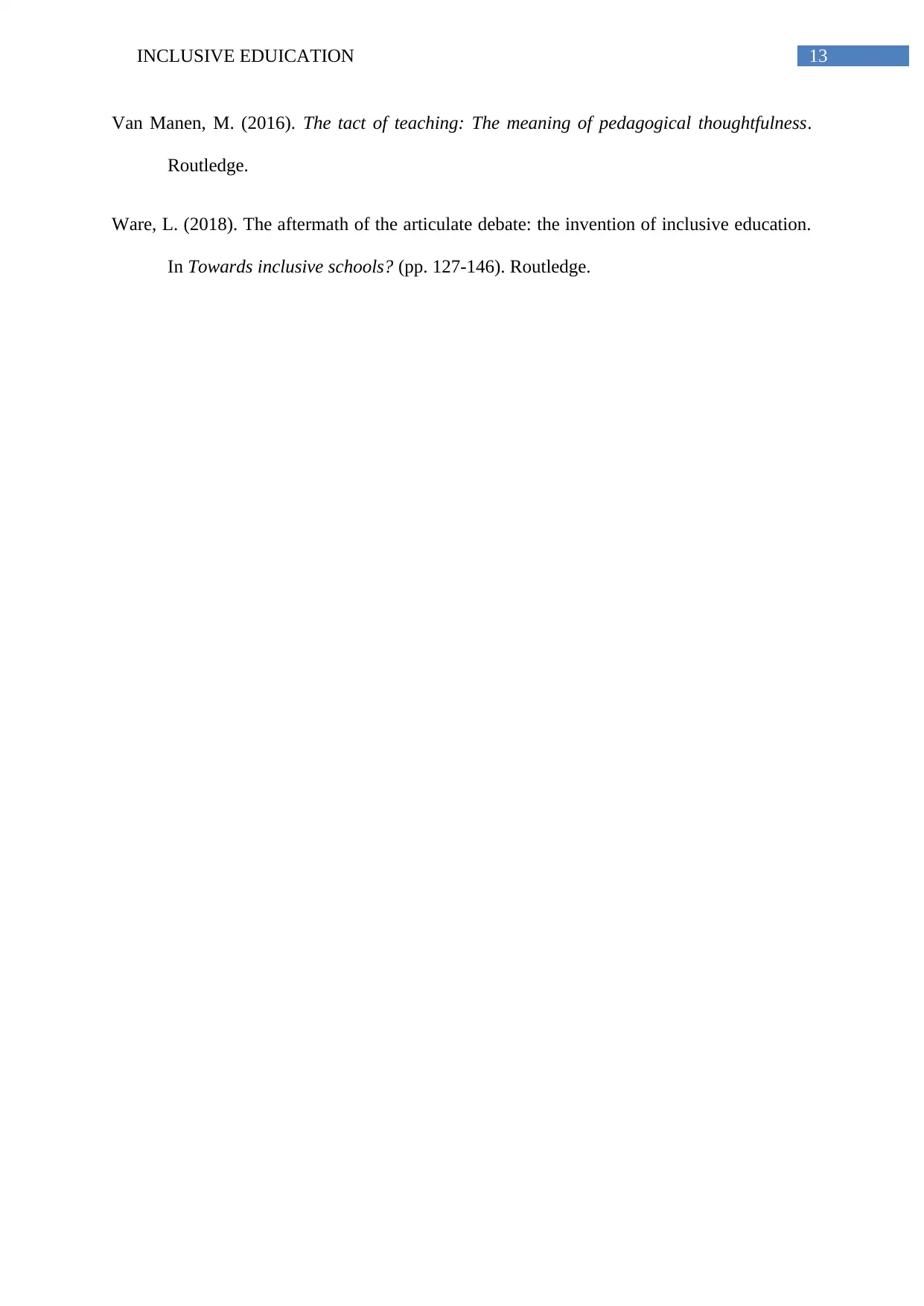
13INCLUSIVE EDUICATION
Van Manen, M. (2016). The tact of teaching: The meaning of pedagogical thoughtfulness.
Routledge.
Ware, L. (2018). The aftermath of the articulate debate: the invention of inclusive education.
In Towards inclusive schools? (pp. 127-146). Routledge.
Van Manen, M. (2016). The tact of teaching: The meaning of pedagogical thoughtfulness.
Routledge.
Ware, L. (2018). The aftermath of the articulate debate: the invention of inclusive education.
In Towards inclusive schools? (pp. 127-146). Routledge.
1 out of 14
Related Documents
Your All-in-One AI-Powered Toolkit for Academic Success.
+13062052269
info@desklib.com
Available 24*7 on WhatsApp / Email
![[object Object]](/_next/static/media/star-bottom.7253800d.svg)
Unlock your academic potential
© 2024 | Zucol Services PVT LTD | All rights reserved.




